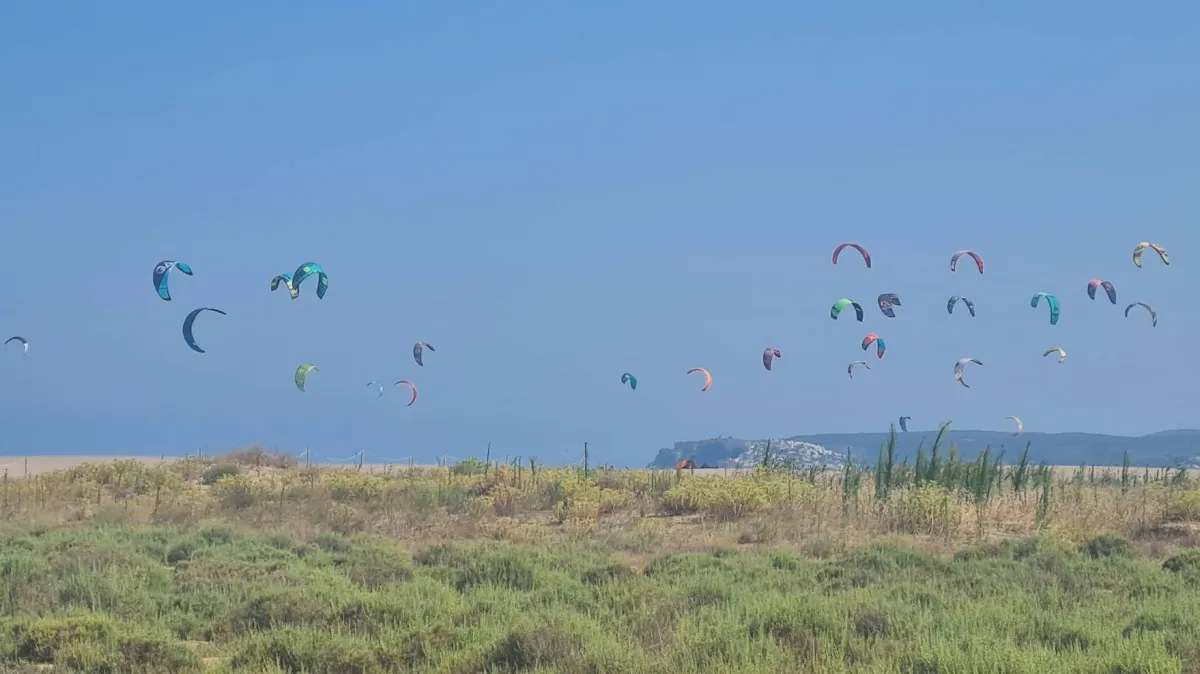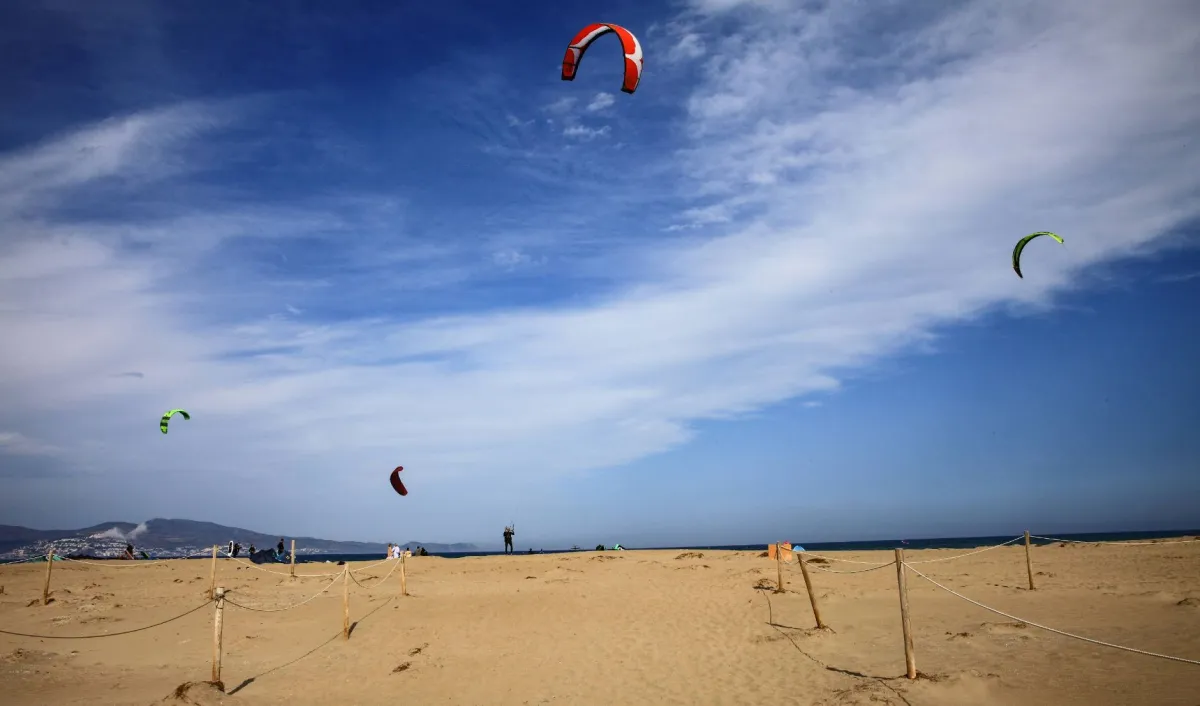Sant Pere Pescador
Figueres - Spain
Spot Type
Chop
Water
Seaweeds
Beach
Sand
Rider Lever
beginner
Spot characteristics
Spot Type
Chop
Rider Skill
beginner
Crowd
Seasonal Crowd
Beach Type
Sand
Water Quality
Seaweeds
Tide Influence
Tide independent
Description of Sant Pere Pescador (Spain)
Sant Pere Pescador is hands down one of my go-to spots when I want a solid session in a relaxed setting with dependable wind and loads of space to ride. It’s located right on the Bay of Roses in Catalonia, northeastern Spain, not far from the French border.
There’s something really special about how this spot feels – the beach is wide, made up of soft golden sand, and the vibe stays welcoming even in the peak of summer. The water close to shore stays nice and flat for about 20 meters before turning slightly choppy, which gives you a smooth runway for launching tricks or just locking in long freeride tacks. Because it’s shallow and sandy all the way through, it’s incredibly beginner friendly. No rocks, no sharp shells to worry about. That alone already sets it apart from a lot of other European coastal spots.
The wind here is most consistent June through September, making summer the high season. You’ll notice a bit of crowding on weekends during those months, but the beach is so long that you still find room to launch and ride safely, no problem. The Tramuntana – that dry, gusty wind blowing down from the Pyrenees – dominates in spring and late autumn, while summer sees a more mellow and steady thermal from the southeast. That southeast seabreeze builds really nicely in the afternoon, which makes for long, cruisy sessions. Wind ranges are usually around 10 to 25 knots, so it’s easy to select your kite size well in advance. Gear-wise, 8 to 12m will cover just about everything here except freak days where Tramuntana howls in extra hard. The setup is also dialed in from a safety and organization standpoint – there are multiple officially designated kite zones, and a section specifically for advanced riders called the Kite Expert Zone. Having those zones in place helps separate swimmers, learners, and more aggressive riders. You won’t have to dodge too many beginners if you head into the advanced area.
The launch zones are wide open, and you’ll find it incredibly straightforward to launch and land your kite solo or with help.Hydrofoil riders are going to love the conditions past the first 20 meters. Once you’re out of the wind shadow and into the chop or the build of the consistent seabreeze, it’s a dream to cruise for hours with minimal obstacles. Freeriders and cruisers will definitely find this spot rewarding, and the vibe is low-key even during peak summer, especially if you simply time your session either early morning or later in the afternoon. Facilities in the area add to the convenience factor.
Several schools line the main stretch of the beach and rent gear or offer private and group lessons. They’re mostly active from April to October, but local riders do hit the beach year-round. Outside the summer, a spring suit is a good idea as water temps drop, and in winter a full wetsuit is a must if you want to stay out for longer. Wind quality in winters can be surprisingly good when Tramuntana kicks in, though less predictable.
Beyond the beach, the surroundings are actually quite scenic. You’ve got the river Fluviá emptying into the bay, birds and natural wetlands that give the place a chill, natural energy. The town of Sant Pere Pescador itself is small but has everything you’ll need – gear shops, places to eat, and some fairly affordable seaside accommodation. Figueres, the closest city, is only half an hour away and good for dialing in logistics or catching culture, like Dalí’s surrealism museum.If you're into freestyle, freeride, or hydrofoil, this place delivers without fuss. As soon as you settle into the wind rhythm, with sea on one side and orchards behind the dunes, you’ll understand why so many riders come back year after year. Whether you're chasing your first water starts or laying down long drawn-out carves, Sant Pere Pescador gives you the foundation and freedom to progress.
Spot Gallery (3)
Spot best suited for
Spot profile
Travel spot
The typical kite travel destination, it is known for its great conditions, and kiters from around the world come here for their vacations.
Family spot
Located in an area that offers amenities for all the family and can provide good alternatives for everyone when the kiters are in the water.
Equipment
A shorty wetsuit works well in summer, but once you move into spring or late autumn, switch to a 4/3 full suit. Winter riders will want a proper 5/4. Water shoes aren’t strictly required due to the sandy bottom.
Wind Conditions
Main wind directions
% of Windy days per month
Wind Speed Range
From 10 to 25 Knots
Suggested sizes
8 - 9 mt
10 - 11 mt
12 - 13 mt
14 mt and above
Forecast on Windy.com
Dangers
Sant Pere Pescador is generally super safe, especially when compared to some of the more rugged Mediterranean spots. The beach is soft sand with no rocks or jutting obstacles, so launching and landing is pretty forgiving even when it’s busy. That said, make sure you’re sticking to the marked kite zones, especially in high season – July and August see more beachgoers and swimmers. It’s not uncommon to get the occasional tourist wandering too close to kite lines because they’re just unaware.
There are three official kite zones including a designated expert area – stick to those and you minimize your risk of incident or unwanted attention from beach patrols, especially during regulated high season days.The main wind danger comes from the Tramuntana. While it can be a dream with 20+ knots of dry, clean power, it can also be gusty and unpredictable. Gusts can launch a beginner off their feet or yank a kite overhead if you’re not paying attention to forecast updates or developing clouds from the inland mountains. That wind often whips down from the Pyrenees fast and can shift, so it’s always smart to launch cautiously and spend a few minutes observing wind consistency before getting on the water.
Another low but notable hazard is seaweed accumulation, particularly after stormy days. It gathers alongshore or occasionally forms floating mats further out. You’ll want to avoid it with your lines and foil wings since it can snag or slow down performance. Lastly, respecting the natural protected areas and dunes is important – there are signs, and locals are rightly protective of the wetlands. No cutting through river mouths or shallow marsh to shortcut back to town – ride around and keep the environment intact so we all can keep enjoying it year after year.
Location
Closest City
Figueres
How to get There
Fly into Girona-Costa Brava Airport – it’s the main hub nearby and sits about 30 km from the beach. From there, grab a rental car or take a taxi to Sant Pere Pescador. It’s also reachable by train into Figueres from major cities like Barcelona, then a quick 30-minute drive. No permits or tricky logistics – just head toward the coast, follow signs, and you’ll land at one of the main access points along the beach where parking is usually available.
Access
The spot is entirely public with open access. No entrance fees, and you usually find free parking close to the beach. During the main summer months, the local authorities do mark out official kite zones and may enforce them, but you won’t encounter gates, permits, or any of that. It’s a low-hassle entry. Just drive to beach-access points at Sant Pere or the kite school parking lots, walk your gear
What to do besides kitesurfing
Sant Pere Pescador itself is a small, chilled-out town just inland from the beach, and it's got all the essentials for a long kite trip or a quick weekend hit. Accommodations range from solid beachside campsites to small boutique hotels and vacation rentals. A lot of riders crash at one of the several camping sites – they’re only minutes from the beach and often have racks or storage for kite gear, showers, and you’ll meet other kiters which adds to the vibe.
Gear shops are sprinkled along the main beach stretch, and you can rent everything from kites and foil boards to SUPs, or book in for private and semi-private lessons. Most kite schools run from April through October, but locals kite even in winter if the wind's working.The food is worth mentioning too – Catalan cuisine is all over town with fresh seafood, tapas, and locally made wine and cheeses.
After your sesh, hit one of the beach bars or head into the village for a plate of pulpo a la gallega or grilled sardines. There’s a laid-back culture here that pairs well with the lifestyle – you kite, grab food, take a nap, go again.Got a non-kiting family or friends with you? No worries – there’s bike paths, birdwatching zones, and scenic routes along the Fluviá river that flows into the bay. Birders and hikers love the wetlands here.
You’re also close to cultural spots like Figueres, renowned for Salvador Dalí’s museum, and other medieval villages worth a day trip when the wind’s offshore or if you just need a break.Weekly markets in town offer fresh produce, baked goods, and local olive oils. It’s got a chill small-town feel, but with everything a rider needs within arm’s reach. During school holidays and weekends, the spot gets busier, but unlike some other high-profile kite beaches, it never feels overrun. That balance – solid wind, safe zones, workable infrastructure, and a laid-back culture – keeps Sant Pere on my annual rotation. Just make sure you bring a couple kite sizes, a suit for the season, and a relaxed mindset. It’s that kind of place.


